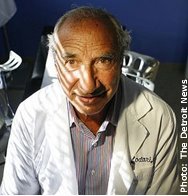Sometime most likely in September of 1929, physician and surgeon H. W. Coulter performed an abortion upon 21-year-old Gene Raligh, leading to her death in Tacoma, Washington on September 18 from septicemia.
Gene's survivors alleged that not only did Coulter injure her, but he also failed to treat her infection and instead concealed the extent of her illness and injury, preventing her from getting medical care that might have saved her life.
An Unknown Perp in Oklahoma, 1958
At around 8:00 on the evening of September 17, 1958, 31-year-old "Glenda Coe" (named changed at request of family) and her four daughters got ready for bed. The girls retired for the night. The eldest girl, 12 years old, awoke at around 1:00 on the morning of September 18, 1958, and went to the master bedroom to find her mother dead. Before her death, Glenda had changed out of her nightclothes and into street clothes.
At first, authorities suspected either natural death or a suicide. However, all evidence indicated that Glenda, a waitress, had been in good health before her death. An autopsy found that Glenda had died due to air bubbles in her bloodstream, and that she had been pregnant at the time of her death. A more careful examination determined that Glenda had died from an abortion attempt.
Glenda and her ex-husband, 34-year-old James Paul Morton, had been divorced for several years. James was arrested for questioning. Witnesses said they had seen him at Glenda's home the night before her death. He was released after four days, though authorities declined to tell the press if he had been cleared or not.
Safe and Legal in North Carolina, 1993
Thirty-six-year-old Kathy McKnight (pictured) of Charlotte, North Carolina underwent an abortion on September 17, 1993. Early the next morning, Kathy had trouble breathing. She was taken to University Memorial Hospital in Charlotte, North Carolina. Kathy died in the emergency room. Her autopsy revealed that she died of a pulmonary embolism.
One of Three at a National Abortion Federation Clinic, 2003
 |
| Dr. Alberto Hodari |
Nurse Litchtig performed an ultrasound, "even though there was no physician order for the study. She interpreted the study as showing a five week pregnancy and signed [Hodari's] name..." Nathanson initialed the ultrasound to confirm Lichtig's finding.
CRNA Thompson did the anesthesia while Dr. Milton Nathanson did the abortion. Regina was given 200 mg of Diprivan, 2 mg Fentanyl, .2mg Gylcopyrrolate, and Droperidol to anestetize her for the abortion, which was charted as taking place from 9:55 to 10:05 a.m.
Regina was then sent to the recovery room, along with five or six other patients under the care of Litchtig. Though clinic protocol required more than one staff person present when patients were in recovery, Lichtig was sometimes alone in caring for the patients.
Though Hodari's recovery room was equipped with a stethescope, oxygen bag/valve mask, and digital blood pressure cuff, it was not equipped with an EKG monitor, pulse oximeter, or automatic blood pressure/pulse monitor with alarm for monitoring patients, or with oxygen, a difibrillator, or other resuscitaiton equipment.
Lichtig recorded Regina's blood pressure and pulse manually upon admission to recovery, and at 10 - 15 minute intervals. At 10:05, Regina's blood pressure and pulse were a normal 116/72 and 82. At 10:15, they were 108/56 and 88. This fall in blood pressure and rise in pulse, especially in combination, are an early sign that a patient might be suffering complications such as blood loss. However, Lichtig reported that Regina's respiration was easy and unlabored.
The document notes that Lichtig was actually performing above the call of duty: Womancare protocol only required her to check a patient's vitals upon arrival in recovery, at 15 minues, and at discharge, usually after about an hour in recovery. Hodari's protocol also allowed for the nurse to discharge patients from the clinic. "There was no provision that the patient be seen by a physician once she was transferred to the recovery room."
At 10:30, Lichtig was unable to rouse Regina, who still had a pulse and unlabored breathing. Lichtig tried for about ten minutes to awaken Regina. At about 10:40, she could no longer detect a pulse. She immediately told CRNA Thompson, who was then wheeling another patient into recovery. The two of them brought Regina back to the OR and began performing CPR. However, nobody called 911 until 11:00, twenty minutes after noting that Regina was pulseless. EMS arrived promptly, at 11:05.
EMS took Regina to Providence Hospital, where with continued CPR and got a pulse. Regina was put on life support, but was pronounced brain dead. She was taken off life support and declared dead on September 18. An autopsy determined that Regina had died from anoxic encephalopathy due to cardiac arrest. In other words, she died because her brain had been deprived of oxygen.
The Administrative Complaint found Hodari to be negligent, incompetent, and lacking in good moral character. Hodari did not contest the findings, instead cooperating with bringing his facility up to standards to pass an inspection by an anesthesiologist in February of 2009. But in the mean time, he'd performed the fatal abortions on Tamiia Russell and Chivon Williams in 2004.
The state Attorney General's office fined Hodari $10,000 on March 4, 2009, for his part in the death.
The latest National Abortion Federation update no longer lists Womancare as a member, though they were recently. They certainly were in 2004, when Chivon and Tamiia died, which is the oldest page of Michigan NAF members that I can find on the Internet Archive. Womancare was also still a member in 2007, the most recent update on the Internet Archive. I'd be very interested in having NAF Annual Reports so I could look up what years Hodari and his mills were members.

1 comment:
Christina, can you e-mail me? I've just read of a case you might want to write about. jrwahlund at gmail dot com
Thanks!
Post a Comment